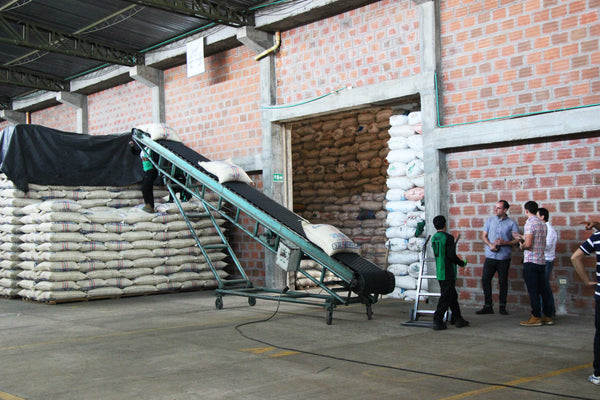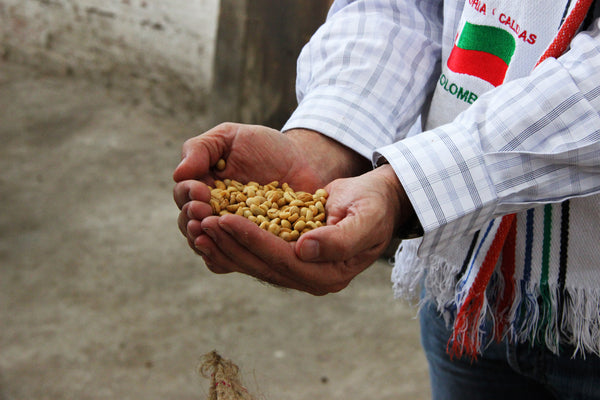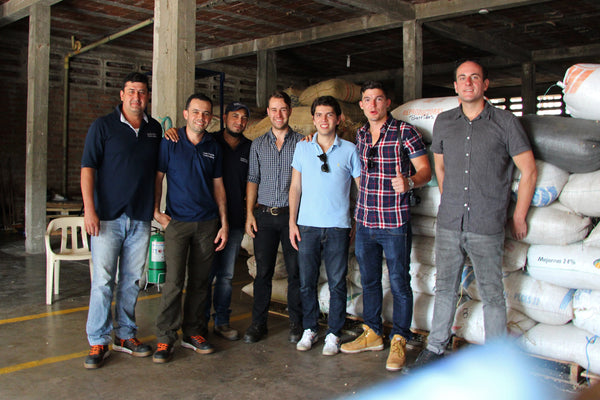In mid-January 2016, Industry Beans Co-Founder Steve Simmons took the opportunity to travel to Colombia with one of our Senior Roasters Tom, and visit key growing regions and meet with farmers, exporters and brokers to discuss existing and new relationships, understand in greater detail the challenges and opportunities in specialty and boutique coffee, and of course, cup coffee. Here's the travel wrap from Steve himself:
 The view over San Juan
The view over San Juan
A little bit of background on evolution of coffee growing in Colombia will assist in contextualising the challenges that farmers face in producing exceptional coffee. In around 2008 Colombia experienced an outbreak of the incredibly damaging leaf rust disease. This disease, cause by the fungus Hemileia vastatrix, has been present in varying degrees across the coffee growing world for generations, however the outbreak from 2008 to 2011 was unprecedented in its intensity. The disease attacks the leaves of the coffee plants, causing them to die and as a result the plant has no method of absorbing sunlight, and therefore performing photosynthesis. Airborne, the disease spreads quickly and the only way to curtail it is to destroy affected plants. As a result:
- In 2008/09 Colombia produced only 8.6 million bags (70kg) of coffee
- This represents a more than 30% decrease compared to the 2007 yield of 12.5 million bags
- In 2013/14 Colombia had recovered to nearly 13 million bags (All statistics courtesy of International Coffee Organisation, Total Coffee Production 1990 – 2016)
On the ground, the devastation caused by leaf rust is galling for farmers.
Arabica (Coffea arabica) species is highly susceptible to leaf rust, while alternative species such as Robusta (Coffea canephora) exhibit desirable leaf rust resistance. Unfortunately, as we well know, the cup quality of Robusta species is inferior to Arabica varietals, and farmers are presented with a challenging proposition – how do we maintain cup quality and production yields when Arabica is so highly susceptible to the damaging leaf rust?
The Federacion National de Cafeteros (FNC) was founded in 1927 to represent the coffee growing industry, develop quality standards, and regulate exports. In 1938 the FNC established a National Coffee Research Center (CENICAFE), tasked with developing new varietals, techniques and strategies for improving coffee quality, yields, and disease resistance. In the 1960s CENICAFE started producing hybrid cultivars, such as:
- Catimor (Caturra x Timor Hybrid)
- Colombia (further evolution of the Catimor)
- Tabi (Typica x Bourbon)
- And most recently, Castillo (again a further evolution of Catimor)
A common theme in developing these cultivars is the hybridisation of Arabica and Robusta genes in an effort to gain increased disease resistance while maintaining cup quality. The best of both worlds according to the FNC and CENICAFE!
This last point continues to be the subject of some conflict between the FNC and specialty roasters who don’t necessarily agree that the hybridised cultivars maintain the cup quality of heirloom (traditional) varietals. The controversy that continues is the FNC promoting, in particular, Castillo to farmers as the preferred cultivar. Promotion occurs in the form of incentives for farmers to plant Castillo in place of heirloom varietals, thus leading to a challenging cost-benefit analysis for farmers – grow higher yielding, disease resistant varietal with a much lower input cost, or buck the trend and grow an heirloom varietal that provides the opportunity for exceptional coffee.
 Coffee Seedlings at Jorge's Nursery in San Juan
Coffee Seedlings at Jorge's Nursery in San Juan
Our observations from cupping a range of cultivars from a variety of growing regions distilled down to this:
- We cupped a number of good quality Castillo samples. None were truly exceptional, but plenty were certainly examples of high quality specialty cups. Highly approachable and drinkable, making valuable, consistent contributions to blends such as the Fitzroy Street, or to be presented as examples of traditional, high quality Colombian coffee. This perhaps fits quite neatly with the general consensus that Castillo certainly has an important role to play in ensuring Colombia continues to produce a consistent, quality coffee.
- We also cupped a range of heirloom varietals, such as Geisha, Bourbon, Caturra and Pacamara. Interestingly, while these certainly produced more expansive and diverse cups, the quality and refinement was a little varied. Growing such varietals as well as processing them effectively is a not-insignificant challenge in itself, and the bourgeoning boutique market is seeking to continue to learn from their experiences in order to produce consistent, exceptional coffees.
- The final observation relates to processing. While Colombia has very traditionally been a fully-washed process coffee producer, farmers are realising the opportunity to experiment with semi-washed and honey, as well as natural processing techniques. Like growing heirloom varietals, experimenting with processing techniques will take some time to achieve high quality, consistent results. The early signs are promising and exciting!
One of the barriers in the way of farmers straying too far from the beaten track is the FNC quality assurance for all exports. Every lot exported from Colombia is cupped by the FNC and declared acceptable or otherwise. In an example of the challenge faced by farmers in exporting distinctive lots, one of the farmers we visited, Jorge, had one natural process lot rejected by the FNC because it was deemed too far removed from the typical Colombia flavour profile….which is exactly the point of creating a natural process lot!
 Senior Roaster Tom Austin discussing green storage and export
Senior Roaster Tom Austin discussing green storage and export
Where less tightly regulated nearby Central America countries such as Panama, Guatemala and Costa Rica have been exporting exemplary and interesting coffees for many years, the ingrained conservatism exhibited by the FNC clearly creates a significant challenge in exporting distinctive Colombian coffees.
Nonetheless, the future is bright for Colombian coffee – overall, exports have recovered to pre-leaf rust crisis levels, which can surely only be a good thing for farmers, roasters and coffee drinkers. Security of one’s livelihood must be the first step in continuing to develop a more diverse and exceptional offering, as the reliable income from high quality specialty coffee allows farmers to access buyers, such as Industry Beans, that are seeking those truly exceptional coffees.

Most encouragingly, we experienced first-hand the passion that farmers have for growing fantastic coffee, tending to stunning estates, and recognising the opportunity to work with exporters and roasters at the apex of high quality specialty coffee.
A special thanks goes to the generous hosts who kindly gave up their time to show us their livelihoods, and extended an incredibly warm welcome to Tom and I, inviting us into their homes, introducing us to their families, and sharing with us their pride and joy on the cupping table.
Thanks for reading,
Steve
Co-Founder
